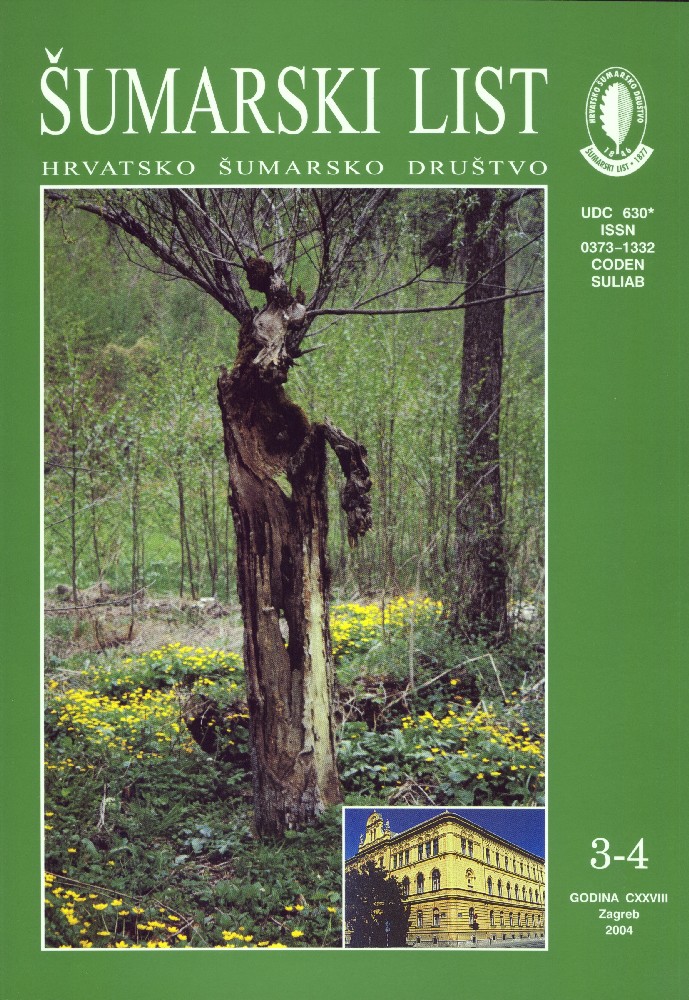
broj: 3-4/2004
pdf (26,7 MB) |
|
||||||||||||||
| IZVORNI ZNANSTVENI ČLANCI | ||
| Belčić, B. | UDK 630* 263 (001) | |
| Structural properties and natural succession of riparian forests at the mouth of the river Mura into the river Drava pdf HR EN | 103 | |
| Krejči, V., Dubravac, T. | UDK 630* 231 + 236.1 (001) | |
| Reforestation problems in peduncled oak forests (Quercus robur l.) of moist type during seed cutting pdf HR EN | 119 | |
| Summary: Today, at a time of widespread disruption of forest ecosystems, in particular in the lowland forests, the need has arisen for study and research on development of particular structural elements in stands.In this study we investigated the development course of Peduncled oak young growth during seed cutting and immediately after completion, in a forest of Peduncled oak and Genisto elatae with caricetosum brizoides (Genisto elatae-Quercetum roboris caricetosum brizoides). Investigations were carried out in a pure Peduncled oak stand of preserved structure in the area of the “Karlovac” Forest Office, Management Unit “Rečički lugovi”, compartment 16a. In the course of eight years, from 1996 to 2003, the development course of Peduncled oak young growth was monitored with regard to soil influence, stand structure, appearance of shrubs and herbaceous plants, voles and deer game. We determined in which period a particular factor of that forest ecosystem has an effect on natural reforestation. Tending and protection of the Peduncled oak young growth commenced at the right time with its appearance under the crown cover and continued until its transformation into the developmental stage of ‘older’ young growth, after seed cuttings had been performed. The soil type is hypogley carbonaceous on heavy clay, which, according to the percental contents of humus, belongs to a highly humus soil. Under a 4-5 cm thick spongy layer of inert matter raw humus there is a highly acid A horizon (pH in water 4.1), 5-8 cm thick. According to Braun-Blanquet the degree of soil cover with Carex brizoides amounted to 4.5. The mass of ground vegetation in fresh state amounted to 7.298 to 7.945 kg per hectare. Seed cuttings were performed on three occasions (1996/1997, 1999/2000 and 2002). After the cuttings, the condition of the soil cover, by horizontal crown projections (shown in Fig. 1), positively influenced the development of the Peduncled oak young growth. Table 2 shows that in 1996, 96 % of the Peduncled oak young growth was in the developmental stage of ‘younger’ young growth. During 1996, 1997 and 1998, the highest percentage decrease in the number of Peduncled oak young growth was recorded, which occurred due to the soil cover effect by Carex brizoides and bites by voles in the root collar zone. During the 2003 measurements, records were taken of 32,778 young Peduncled oak trees, of around 10 years of age, in the developmental stage of ‘older’ young growth”, which showed a five-fold decrease compared to the initial situation of 149,694 young oak trees in 1996. The situation in the development of shrubs is shown in Table 3, which indicates that during the eight years a five-fold increase occurred. However, this should not be disturbing in view of the powerful height increment in the ‘older’ young growth and young growth of Peduncled oak. In the course of this investigation the deer game effect on the development of Peduncled oak young growth appeared to be negligible. It can be concluded that the marked acidity of the A horizon soil did not affect the appearance of young growth, and that during seed cuttings the area of young growth, as soon as seedlings and young growth appear, should be tended and protected. Following the appearance of young growth in the structurally preserved stands, the period of young growth, with timely seed cuttings, should not be longer than 10 years. Key words: Peduncled oak; young growth; reforestation; soil; Carex brizoides; shrubs; voles; deer game | ||
| Krpan, A. P. B., Poršinsky, T. | UDK 630* 323 + 362 : 30 (001) | |
| Efficiency of Mechanical Felling and Processing in Soft and Hardwood broadleaved stands – Part 1: Attitudes of Forest Professionals towards Mechanical Felling and Processing pdf HR EN | 127 | |
| PREGLEDNI ČLANCI | ||
| Seletković, I., Potočić, N. | UDK 630* 425 | |
| Crown Condition of Forests in Croatia for the Period 1999–2003 pdf HR EN | 137 | |
| Vizentaner, J. | UDK 630* 272 | |
| Inventarisation of trees and shrubs in the Park round prince Eugen Franjo of Savoya and Piemont castle in Bilje pdf HR EN | 149 | |
| Martinić, I. | UDK 630* 907.1 | |
| Forestry Profession in View of the Establishment of Ecological Network of the Republic of Croatia pdf HR EN | 163 | |
| STRUČNI ČLANCI | ||
| Konjević, D., Janicki, Z. | UDK 630* 156 + 132 | |
| Diseases of Game, Zoonosis and Possible Methods for Conducting the Preventive Measures pdf HR EN | 173 | |


